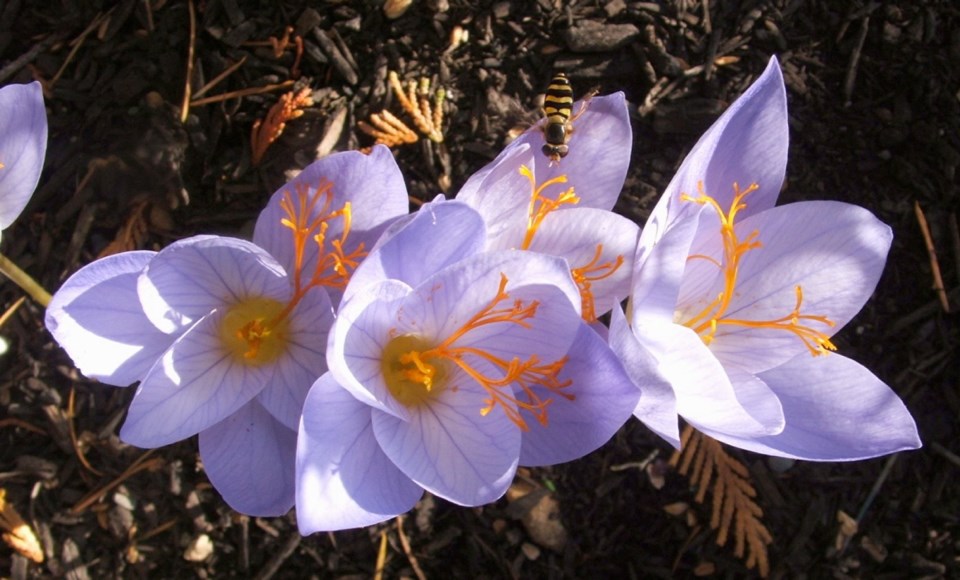Brilliant sunshine and crisp, comfortable temperatures for much of October have more than made up for September’s rainy gloom. The long run of sunny days made clear the shifting seasonal patterns of light in the garden and highlighted the vivid autumn colours.
The star of the show in my garden is a sorrel tree (Oxydendrum arboreum, sourwood), whose long-fingered clusters of white flowers stand out against the tree’s deep scarlet leaves.
An oakleaf hydrangea has taken on rich shades of purple and burgundy. A row of blueberries shines in copper and red.
Patches of fall crocus have stood upright, their blossoms sparkling, bright stamens seeming to wave an invitation to flying insects passing by.
The sight of them is a special treat. Too often, fall crocuses are turned into soggy messes in autumn rains. This month, they’ve been dazzling.
A favourite, Crocus speciosus, stands out for its larger bloom size than most fall crocuses and for its lovely silvery lilac-blue flowers with darker veins.
Even parts of the vegetable garden are making a rather fetching show. One plot of red and variegated (Castelfranco) radicchios is edged in a short row of robust Brussels sprouts plants, their stalks filled thickly with swelling sprouts.
It won’t be long before I’ll be snapping a few off for a dinner highlight of halved sprouts fried in butter, briefly, in a covered pan. Simply, exquisitely, delicious.
Freshened flowers
At a recent birthday breakfast with a group of friends, everyone was remarking on how cooling temperatures and rainfall in September, followed by a sunny October, perked up summer plantings that were looking parched and weary after a hot, dry summer.
Municipal plantings that we walked by on the way to breakfast were looking remarkably refreshed.
We noticed particularly a grouping of heliotrope, a summer flower not seen so much these days. I used to grow it every year, for plants to grow with tomatoes and cucumbers to attract pollinating insects.
Bees are powerfully attracted to the flower clusters. The planting we saw was low growing, with broccoli-like clusters of purple flowers over dark foliage. The blooms’ rich vanilla fragrance was becoming pronounced in the warming morning sunshine.
The planting prompted me to list heliotrope as a flower to grow again next year. William Dam Seeds lists Marine, the variety I used to grow.
Stokes Seeds lists the slightly taller (60 cm) Marine Lemoine Strain. Heliotrope was popular in Victorian times, when the plant was commonly known as “cherry pie” because of the sweet scent like cherries cooking.
The violet-purple flowers are ideal companions for dwarf marigolds.
Tips for the times
• Staking. Late fall and winter storms are coming. Some winter and over-wintering vegetables, notably Brussels sprouts and purple sprouting broccoli, have developed into substantial plants in the late summer and early fall weather.
To stabilize them against winter wind and the weight of possible snowfall, consider staking at least the taller plants. Continue monitoring the others for a tendency to lean.
• Bulbs. Home gardeners have become familiar with the popular dwarf narcissus called Tête à Tête, a versatile little bulb flower easily tucked into container plantings and front corners of flower beds.
Less known is the recently introduced double-flowered version of Tête à Tête, called Tête Bouclé (literally, “curly head”), a showy little daffodil.
Dwarf irises are another favourite spring flower. ‘Kathryn Hodgkin’ is a beauty in pale blue and gold with dark striping and speckling. New this fall in some garden centres are ‘Alida’ in shades of blue with white and yellow markings and ‘White Caucasus’ in pristine white with bright yellow markings.
Both narcissus and dwarf irises are described as deer resistant.
Garden events
Lily auction. The Victoria Lily Society is hosting its11th Annual Rare Bulb and Plant Auction on Monday, Oct. 29, at the Horticulture Centre of the Pacific, 505 Quayle Rd. in Saanich. It’s an opportunity to bid on bulbs from hybridizers across Canada and Washington state as well as on rare items from members’ gardens. The event begins at 6 p.m. with wine and cheese and viewing of silent auction items. The live auction begins at 7 p.m. Non-members welcome. victorialilysociety.ca
HCP free admission. On Wednesday, Oct. 31, from 9 a.m. to 5 p.m., admission is free to the Horticulture Centre of the Pacific gardens for anyone in a Halloween costume.



